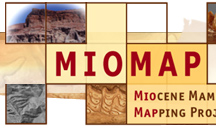POSITIONAL ACCURACY:
Latitudes and longitudes
are those interpolated from the publications that reported the fossil
sites. In most cases these are not exact. Rarely were latitudes and
longitudes reported, especially in older literature. Commonly, geographic
positions were given in USGS section, township and range. These coordinates
were converted to latitude and longitude by using the conversion routines
at http://www.esg.montana.edu/gl/trs-data.html
or http://www.topozone.com (now http://www.trails.com). In some cases only a geographic description was given in publications; these localities were assigned a latitude and longitude that corresponded with the geographic description, thus are only approximations of where the true locality lies, and in the worst cases are plotted at the center of the county in which they occur. Color coding showing the accuracy of sites is available on the interactive maps.
Accuracy is
expressed as:
EXACT if the
latitude and longitude were reported;
TOWNSHIP if the
latitude and longitude was inferred from a USGS section/township/range
description;
QUAD PRECISE
if the locality description allowed precise placement on a USGS quadrangle
map (usually 7.5’);
QUAD APPROX if
the description allowed placement on a portion of the map but was
not detailed enough for precise placement;
COUNTY CENTER
if the locality information was so lacking that the best resolution
was placing it in a certain county.
In general, EXACT
and TOWNSHIP imply that the locality is within a 1km radius of the
latitude and longitude in the database, QUAD PRECISE within about
a 5 km radius, QUAD APPROX within about a 10 km radius, and COUNTY
CENTER within a county.
A representative
number of localities were verified on the map plots to ensure that major
positional errors were not present. In general the positions are those
inferred from our reading of the primary literature and have not been
ground-truthed. Latitudes and longitudes were recorded using the WGS84/NAD83
coordinate datum.
As of 2004 the
Landsat images used in the map interface and provided by the JPL WMS
service have an offset of 100-200 meters worldwide. JPL was working
to fix this but it is unknown when the fix will be completed.






